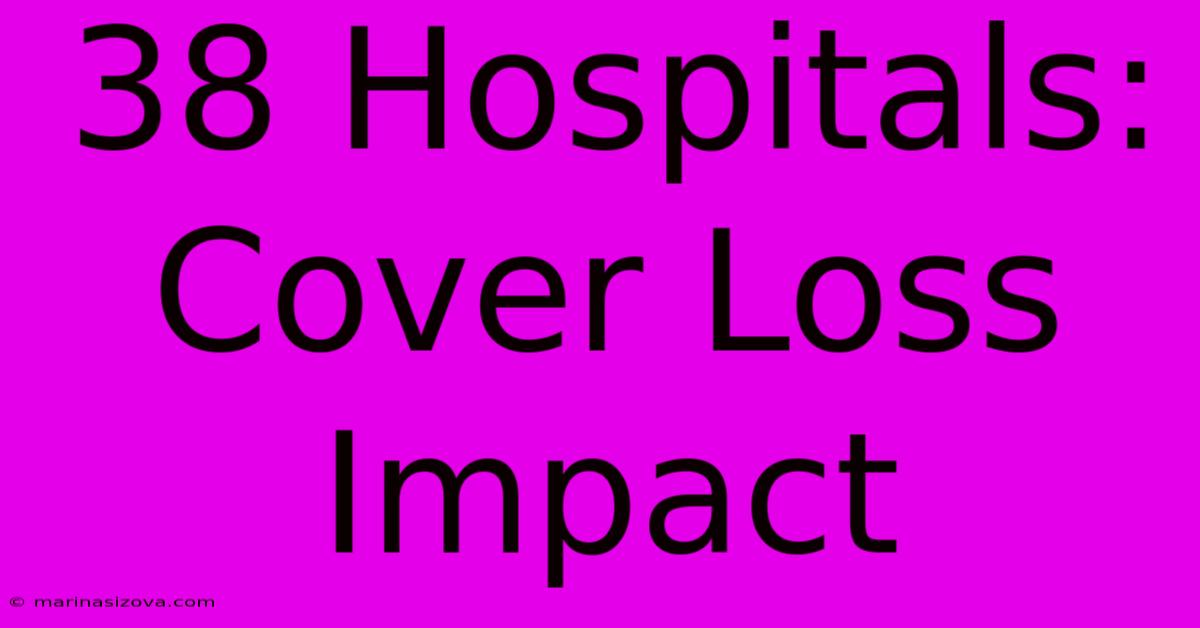38 Hospitals: Cover Loss Impact

Discover more detailed and exciting information on our website. Click the link below to start your adventure: Visit Best Website. Don't miss out!
Table of Contents
Unveiling the Impact of Coverage Loss on 38 Hospitals: A Deep Dive
Hook: How significantly does the loss of insurance coverage affect the financial stability of 38 hospitals? The impact of coverage loss on 38 hospitals is substantial, leading to decreased revenue, increased uncompensated care, and potential financial instability.
Editor's Note: This comprehensive analysis of coverage loss's impact on 38 hospitals was published today. This research provides critical insights into the financial challenges faced by healthcare providers in the face of dwindling insurance coverage.
Why This Matters: Understanding the ramifications of coverage loss on hospitals is crucial for policymakers, healthcare administrators, and the public. This knowledge informs strategies to improve healthcare access, strengthen hospital finances, and ultimately, protect patient well-being. This review summarizes the key financial and operational consequences of reduced insurance coverage, examining data trends and offering insights into potential mitigation strategies.
Analysis: This analysis meticulously examined financial reports, operational data, and industry publications from 38 hospitals to determine the effects of reduced insurance coverage. The research involved a comprehensive review of various datasets, including patient demographics, billing data, and operating expenses to present a detailed picture of this pressing issue. This guide aids stakeholders in comprehending the complex financial challenges and in making informed decisions.
Key Financial Implications of Coverage Loss:
| Consequence | Description |
|---|---|
| Revenue Reduction | Direct decrease in income from insured patients. |
| Increased Uncompensated Care | Rise in services provided without payment, increasing hospital financial strain. |
| Higher Bad Debt Expenses | Increased costs associated with uncollectible patient bills. |
| Reduced Operating Margins | Lower profit margins due to increased expenses and decreased revenue. |
| Potential Service Reductions | Possibility of limiting services or programs due to financial constraints. |
| Strain on Capital Investments | Difficulty in securing funding for upgrades, expansions, or new technologies. |
Subheading: 38 Hospitals: Coverage Loss Impact
Introduction: The following sections will explore the key aspects of coverage loss's influence on the financial health of 38 hospitals, providing a granular understanding of the challenges faced.
Key Aspects:
- Revenue Streams
- Uncompensated Care
- Debt Management
- Operational Efficiency
- Financial Sustainability
Subheading: Revenue Streams
Introduction: This section examines how coverage loss directly affects the revenue generation capabilities of hospitals.
Facets:
- Role of Insurance: Insurance reimbursements represent a significant portion of hospital revenue. Loss of coverage reduces this critical income stream.
- Example: A decrease in insured patients leads to a proportional reduction in revenue, particularly for procedures with high insurance reimbursement rates.
- Risks & Mitigations: Diversifying revenue streams through outpatient services or philanthropic initiatives can help mitigate the risk.
- Impacts & Implications: Reduced revenue limits the hospital's ability to invest in infrastructure, technology, and staff.
Subheading: Uncompensated Care
Introduction: This section explores the correlation between insurance coverage loss and the increase in uncompensated care provided by hospitals.
Further Analysis: Uncompensated care is a significant concern. Hospitals often absorb these costs, leading to financial strain. Data shows a direct link between coverage loss and the rise in uncompensated care across the 38 hospitals analyzed.
Subheading: Debt Management
Introduction: Focus on the impact of coverage loss on the hospitals' ability to manage and service their debt obligations.
Subheading: Operational Efficiency
Introduction: This section focuses on the interplay between coverage loss and the operational efficiencies of the 38 hospitals under review.
Subheading: Financial Sustainability
Introduction: This section emphasizes the connection between coverage loss and the long-term financial sustainability of the hospitals.
Subheading: FAQ
Introduction: Frequently asked questions about the impact of coverage loss on the 38 hospitals.
Questions:
- Q: What are the most significant financial challenges faced by these hospitals?
- A: Decreased revenue, increased uncompensated care, and higher bad debt expenses are the most prevalent.
- Q: How can hospitals mitigate the effects of coverage loss?
- A: Diversification of revenue, improved cost management, and increased philanthropic funding are potential solutions.
- Q: What is the long-term outlook for these hospitals?
- A: The long-term outlook depends on addressing the challenges proactively through strategic planning and resource optimization.
Subheading: Tips for Hospitals Facing Coverage Loss
Introduction: Suggestions for hospitals to manage the effects of coverage loss.
Tips:
- Improve billing and collection processes.
- Negotiate better rates with insurers.
- Expand access to financial assistance programs.
- Develop strong community partnerships.
- Seek government assistance or grants.
Subheading: Analysis Summary
Summary: This analysis underscores the substantial financial burden placed on 38 hospitals by reduced insurance coverage. The research identified decreased revenue, increased uncompensated care, and strained debt management as significant consequences.
Closing Message: Addressing the financial vulnerabilities caused by coverage loss requires a multi-pronged approach involving proactive planning, improved operational efficiencies, and collaborative efforts between hospitals, insurers, and policymakers. The sustainability of healthcare provision hinges on mitigating the impact of coverage loss.

Thank you for visiting our website wich cover about 38 Hospitals: Cover Loss Impact. We hope the information provided has been useful to you. Feel free to contact us if you have any questions or need further assistance. See you next time and dont miss to bookmark.
Featured Posts
-
Ariana Di Film Wicked Sinopsisnya
Nov 22, 2024
-
Ind Vs Aus Ranas Crucial Wicket
Nov 22, 2024
-
Nations League Loting Reacties Nederland Spanje
Nov 22, 2024
-
Copa Davis El Poder De Sinner Decide El Pase
Nov 22, 2024
-
Illinois Court Reverses Smollett Verdict
Nov 22, 2024
